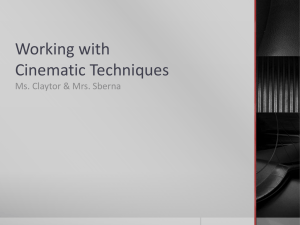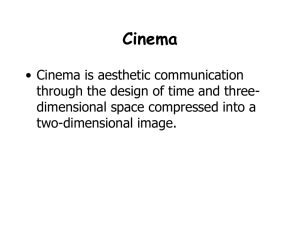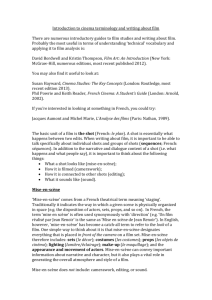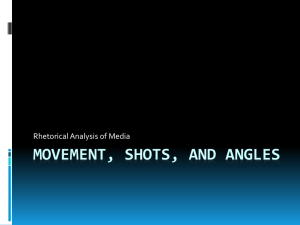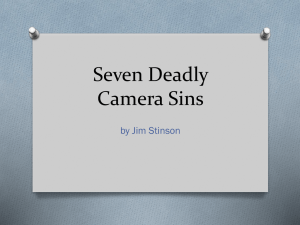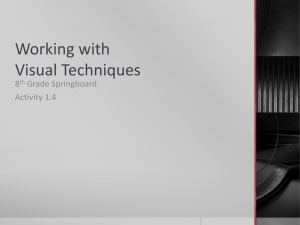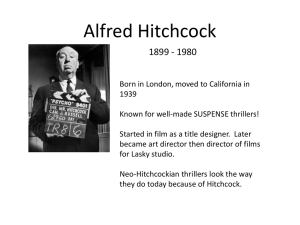Scissorhands Film study Power Point
advertisement
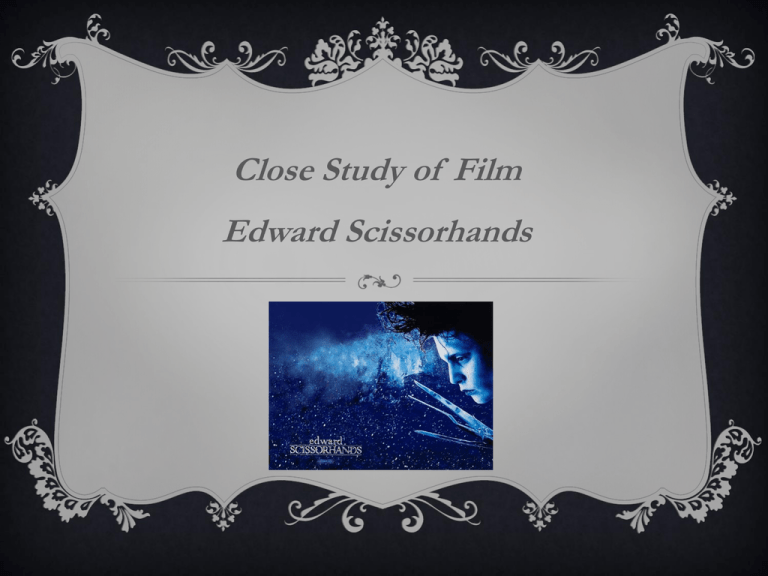
Close Study of Film Edward Scissorhands LANGUAGE OF FILM A close study of film entails a critical knowledge of how film is constructed and why. Identification and analysis of cinematography including : camera shots, angles, score, dialogue, mise-en-scene, lighting, motif, as well as themes, issues, ideas, audience, purpose and context provides us with insight into the way film is purposefully shaped to become a text type worthy of study. PROVENANCE Released: 1990 Director: Tim Burton Film Company: 20th Century Fox Story by Tim Burton and Caroline Thompson (screenplay) Score: Danny Elfman Actors: Johnny Depp; Winona Ryder ;Dianne Wiest ;Anthony Michael Hall; Kathy Baker; Vincent Price; Alan Arkin DEFINITIONS Cinematography: The art or technique of movie photography, including both the shooting and development of the film. Camera shots: the framing used by the director to construct a response from the audience. Includes : close, medium close up, mid shot, long, extreme close up, extreme long shot, conversation Camera movement: tracking, dolly shots, transition shots, zoom Camera Angles: eye-level, high, low, bird’s-eye; dutch tilt(slant) Score: diagetic – sound that the actors and the audience can hear and nondiagetic: sound only the audience can hear Lighting: key lighting, back lighting, spotlight, shadow, natural, artificial, Dialogue: conversation – with other characters or direct address to the audience; voice overs VIEWING THE FILM As you view the film you should enjoy the narrative concepts Look for purposeful use of camera shots, angles, mise-en-scene, score, lighting and dialogue Identify and record any major themes, issues, ideas or contexts LINKS TO LITERATURE Edward Scissorhands (1990) makes indirect allusions and pays filmic homage to the Gothic underpinnings of Mary Shelley’s Frankenstein (1818). Read more about Tim Burton’s fascination with the Gothic here. Edward Scissorhands has folk tale elements that align it with concepts in Beauty and the Beast, Romeo and Juliet and Pinocchio. T H E M E S, I S S U E S A N D I D E A S Burton states that the key themes of the text are isolation and self discovery. Issues explored in the text are conformity, social acceptance, fear and segregation leading to the social rejection of outsiders, beauty is often evident in abstract forms, overcoming peer pressure and personal boundaries. A key idea in the text is the irony of rejecting a constructed being when we are all constructed, controlled and manipulated to conform and be accepted in society. D E C O N S T RU C T I N G T H E F I L M The following stills will provide you with evidence of how film techniques are used to shape meaning. Your role, as a film analyst, is to evaluate their purpose and effectiveness. You will be provided with analysis sheets to workshop your ideas. Once completed, you should be able to deconstruct whole scenes and write discrete paragraph analyses of how and why the director has used film techniques to create specific effects. You should evaluate how the overall cinematic experience has impacted on the audience, insightfully challenging notions of identity, isolation and self discovery. CAMERA SHOTS Close up CAMERA SHOTS Mid shots CAMERA SHOTS Extreme long shot, wide angle CAMERA SHOT Long shot, symbolism CAMERA SHOTS Mid shot, fade filter, costuming, colour contrast (white/black) as symbolism, irony. CAMERA SHOTS Panoramic shot CAMERA SHOTS Conversation shot CAMERA SHOTS Mid shot, long shot, point of view, juxtaposition, genre, motif(mirror) CAMERA ANGLES Low angle CAMERA ANGLES High angle, panoramic shot, use of colour and setting. CAMERA ANGLE Low angle, mid shot, contrast, colour MONTAGE LIGHTING VISUAL MOTIF Colour VISUAL MOTIF Snow SYMBOLISM Scissors LITERARY ALLUSIONS Romeo and Juliet LITERARY ALLUSIONS Frankenstein GENRE Gothic/Horror GENRE Romantic; Satire; Fantasy SET CONSTRUCTION DIALOGUE Dialogue trivia: Johnny Depp, as Edward, only says 169 words throughout the film. The lack of dialogue suggests Edward’s innate understanding of the importance of silence. SCORE The music for Edward Scissorhands was composed by Danny Elfman. The most remarkable aspect of the Edward Scissorhands score is its ability to tell Burton's story without the visuals. The album takes you on the journey of this fable with masterful precision, embodying the heart-wrenching emotions of Edward's discovery and downfall with thematic and choral elements never restrained. http://www.filmtracks.com/titles/edward_s.html

